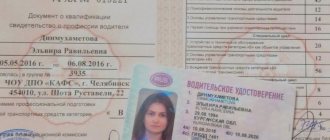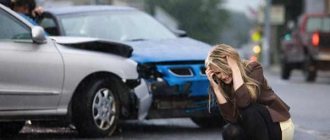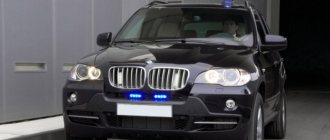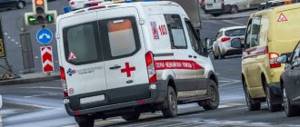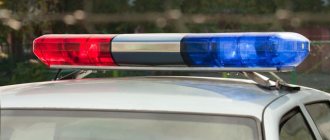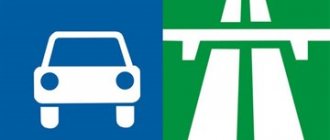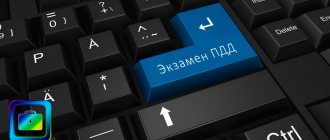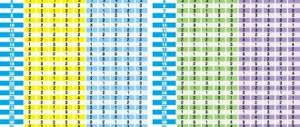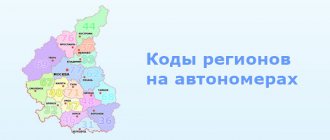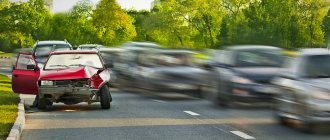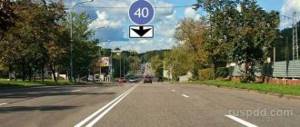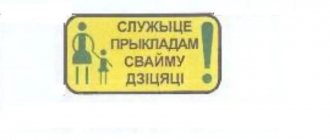Answers to traffic rules tickets category SD
Question 1
How many carriageways does this road have?
1. One. 2. Two. 3. Four.
A comment
This road has two carriageways separated from each other by a dividing strip (clause 1.2), each of which has two lanes for traffic. Answer - 2
Question 2
In which directions can you continue driving a truck with a permissible maximum weight of more than 3.5 tons?
1. Just straight. 2. Straight and to the right. 3. Forward and backward.
A comment
Signs 4.1.1 “Move straight ahead” and 8.4.1 “Type of vehicle” require trucks with a permissible maximum weight of more than 3.5 tons to move only in the forward direction. Thus, you are only allowed to drive through the intersection in the forward direction. Answer - 1
Question 3
Is it permitted to board (disembark) passengers or load (unload) a vehicle within the coverage area of this sign?
1. Allowed. 2. Allowed if it takes no more than 5 minutes. 3. Prohibited.
A comment
Sign 3.28 “Parking prohibited” does not prohibit stopping, i.e. deliberate cessation of movement for up to 5 minutes, and when boarding (disembarking) passengers or loading (unloading) of a vehicle and for a longer time (clause 1.2, the term “Stop”). Answer - 1
Question 4
Which of the following signs allow you to make a U-turn?
1. Only A. 2. B and C. 3. All.
A comment
Sign A (3.18.2 “No left turn”) prohibits only a turn, but not a U-turn. Signs B (5.7.2 “Exit onto a one-way road”) and B (5.13.2 “Exit onto a road with a lane for route vehicles”) also do not prohibit turning around at the intersections of such roads. The answer is 3
Question 5
What should you follow if the meanings of road signs and horizontal marking lines contradict each other?
1. Requirements for marking lines. 2. Requirements of road signs. 3. The rules do not regulate this situation.
A comment
Drivers must be guided by the requirements of road signs, including temporary ones, if they contradict the requirements of horizontal marking lines (Appendix 2). Answer - 2
Question 6
What should you do in this situation?
1. Continue driving without changing speed. 2. Reduce your speed and be prepared to stop immediately if necessary. 3. Stop near the traffic police vehicle and continue driving only after permission from the police officer.
A comment
The rules require that when approaching a stationary vehicle with a blue flashing light on, you should reduce your speed and be prepared to stop if necessary (clause 3.3). Answer - 2
Question 7
When should the turn signals stop signaling?
1. Immediately before the start of the maneuver. 2. Immediately after the start of the maneuver. 3. Immediately after completing the maneuver.
A comment
The turn signal signal must be stopped immediately after completing the maneuver, so as not to mislead other road users regarding the driver’s further actions (clause 8.2). The answer is 3
Question 8
Which trajectory can you use to make a left turn?
1. Only along trajectory A. 2. Only along trajectory B. 3. Along any trajectory from those indicated.
Comment Before turning left or making a U-turn, you must take the extreme left position on the roadway in advance. But at this intersection on the left there are tram tracks located at the same level with the roadway, and there are no signs 5.15.1 “Directions of traffic along the lanes” or 5.15.2 “Directions of traffic along the lanes”. In this case, you must turn left from the tram tracks in the same direction (clause 8.5), i.e. along trajectory A. Answer - 1
Question 9
The driver accidentally passed the required entrance to the yard. Is it legal to use reverse in this situation and then turn right?
1. Allowed. 2. Allowed if the driver drives a cargo taxi. 3. Prohibited.
A comment
Sign 5.5 “One-way road” does not prohibit reversing. In this situation, using reverse gear and then turning right into the yard is permitted, provided that the maneuver is safe and does not interfere with other road users (clause 8.12). Answer - 1
Question 10
At what speed do you have the right to continue driving in a populated area in the left lane?
1. No more than 40 km/h.
2. No more than 60 km/h. 3. Not less than 40 km/h and not more than 60 km/h. Comment Sign 4.6 “Minimum speed limit” with plate 8.14 “Traffic lane” requires driving in the left lane at a speed of at least 40 km/h. However, in a populated area you do not have the right to reach a speed of more than 60 km/h (clause 10.2). The answer is 3
Answers to traffic rules tickets category SD
Question 11
In which lane can you continue driving in a populated area after getting ahead of a truck?
1. Only on the right. 2.Only on the left. 3. For any.
A comment
In populated areas on roads that have two lanes in a given direction, it is allowed to use any most convenient lane (clause 9.4). Therefore, once you get ahead of a truck, you can continue driving in any lane. The answer is 3
Question 12
Which truck drivers violated parking rules?
1. Both. 2. Only the driver of car A. 3. Only the driver of car B. 4. No one violated.
A comment
In this situation, both trucks are parked correctly, since sign 6.4 “Parking (parking space)” with plate 8.6.1 “Method of parking a vehicle” allows parking of all vehicles only parallel to the edge of the roadway (Appendix 1). Consequently, none of the truck drivers violated the parking rules. The answer is 4
Question 13
You intend to drive through the intersection in the forward direction. Your actions?
1. Stop in front of the stop line. 2. Continue driving, giving way to a passenger car. 3. Continue driving, having priority over a passenger car.
A comment
When driving in the direction of the arrow turned on in the additional section simultaneously with a red traffic light, you are obliged to give way to vehicles moving from any other directions (clause 13.5). In this situation, moving in the right lane, you can continue driving without stopping in front of the stop line, but at the same time give way to a passenger car. Answer - 2
Question 14
What should you do when turning right?
1. Go through the intersection first. 2. Give way only to passenger cars. 3. Give way to cars and motorcycles.
A comment
You will pass the intersection of equivalent roads first, since for a passenger car and a motorcycle turning left you are “an obstacle on the right” (section 13.11). Answer - 1
Question 15
If it is impossible to determine the presence of surface on the road (darkness, mud, snow, etc.), but there are no priority signs, then:
1. You have the right to believe that you are on the main road. 2. You should assume that you are on an equivalent road. 3. You should consider that you are on a minor road.
A comment
If the driver cannot determine the presence of surface on the road (darkness, mud, snow, etc.), and there are no priority signs, he must assume that he is on a secondary road (clause 13.13). The answer is 3
Question 16
In this situation you:
1. Must give way to a bus starting from the designated stopping place. 2. You have an advantage, since the bus starts moving into the left lane.
A comment
In a populated area, you must give way to a bus starting from a designated stop, including when it enters the left lane (clause 18.3). Answer - 1
Question 17
What external lighting devices should be turned on at night and in conditions of poor visibility, regardless of road lighting, as well as in tunnels on towed motor vehicles?
1. Daytime running lights. 2. Side lights. 3. Rear fog lights.
A comment
In the dark and in conditions of insufficient visibility, regardless of the road lighting, as well as in tunnels on towed vehicles and trailers, side lights must be turned on (clause 19.1). Answer - 2
Question 18
A driver who has committed an administrative offense will have his driver's license confiscated:
1. When identifying and suppressing an offense. 2. Immediately after a decision is made to deprive the right to drive vehicles. 3. After the decision on deprivation of the right to drive vehicles comes into force.
A comment
Confiscation of a driver's license is carried out in the event of execution of a decision on deprivation of the right to drive vehicles (Part 1 of Article 32.6 of the Code of Administrative Offenses). The resolution is subject to execution from the moment it comes into force (Part 2 of Article 31.2 of the Administrative Code). As a general rule, the decision comes into force after the expiration of the period established for appealing the decision, if it has not been appealed or protested (clause 1 of Article 31.1 of the Administrative Code). The answer is 3
Question 19
To stop a skid caused by braking, the driver must first:
1. Stop braking. 2. Disengage the clutch. 3. Continue braking without changing the force on the brake pedal.
A comment
Skidding on a slippery road can occur when braking due to the rear wheels of the car blocking. In this case, it is necessary to first eliminate the cause of the skid, i.e. stop braking. In the future, by turning the steering wheel in the direction of the skid, you can align the trajectory of the car. Answer - 1
Question 20
What needs to be done to remove a foreign body that has entered the victim’s respiratory tract?
1. Place the victim face down on your knee and punch him on the back several times.
2. Induce vomiting by pressing on the root of the tongue. If the result is negative, hit the victim’s back with the edge of your palm or stand in front and press firmly with your fist on his stomach. 3. Stand on the side of the victim, supporting him with one hand under the chest, with the other hand tilt the victim’s body forward, head down. Apply five sharp blows with the heel of your palm to the area between the shoulder blades. If the result is negative, stand from behind, grab it with both hands just above the navel, clasp your hands and sharply press five times on the abdominal area inward and upward. A comment
Signs of foreign body penetration: noisy and difficult breathing, inability to speak. To remove a foreign body, it is necessary to stand on the side of the victim, supporting him with one hand under the chest, and with the other hand tilt the victim’s body forward, head down. Apply five sharp blows with the heel of your palm to the area between the shoulder blades. If the result is negative, stand from behind, clasp it with both hands just above the navel, clasp your hands and sharply press five times on the abdominal area with clasped hands in the direction inward and upward. Repeat these manipulations alternately until the foreign body can be removed. The answer is 3
Answers to traffic rules tickets category SD
1 2 3 4 5 6 7 8 9 10 11 12 13 14 15 16 17 18 19 20 21 22 23 24 25 26 27 28 29 30 31 32 33 34 35 36 37 38 39 40
ABM categories
1010 RK tests
Administrator of the PDDOK website. Send suggestions and comments to:
© pravila.online. Reproduction of materials is possible if there is an active link
Overtaking, oncoming traffic
Overtaking is considered to be the advance of one or more vehicles into the oncoming lane .
Advancing traffic within the carriageway of the same direction is not considered overtaking.
Before overtaking, the driver must be 100% sure that the maneuver is safe. This requires both experience and cold calculation. It’s better not to take risks if the speed is already more than 80 km/h and you have less than 5 years of experience.
Read more here
Using a traffic rules cheat sheet - warn
I would like to immediately warn you about the use of the traffic rules cheat sheet and about the possible sanctions against those who use it.
At an internal exam at a driving school, for using a cheat sheet, you can be suspended from further passing and ordered to retake, of course, for an additional fee. Well, if you decide not to stop and bring a cheat sheet on traffic rules with you to the exam at the traffic police, you can only imagine what the dangers will be. Personally, I don’t know of such cases, and it seems to me that retaking may not be enough. The traffic police is an official institution, the employees all have a legal education, and I think they will be able to apply to you some article from the administrative code for using a cheat sheet on traffic rules during the traffic police exam.
And here is what the culprit of possible troubles looks like. As you can see, a table is presented with the ticket numbers vertically and the task number horizontally; at the intersection we get the correct answer according to the traffic rules. This way you can test your knowledge of traffic rules of categories A and B.
Many people ask if there are traffic rules answers on the CD, no, they don’t exist, because. While studying at a driving school, many had to take a traffic knowledge test on a computer, and noticed that when they made mistakes, upon completion of the test, all incorrect answers were shown with an explanation and the number of the article from the traffic rules. Therefore, there is no point in having a cheat sheet on the SD. And there is no point in using this type of cheating in any exam.
Of course, you won’t be able to pass the traffic police exam according to the rules using a cheat sheet, don’t even try, it’s fraught with consequences. But at the internal exam at a driving school, passing traffic rules with tickets may help, I haven’t tried it myself, and I won’t recommend it...
What is a traffic rules cheat sheet? These are answers to the traffic rules themselves in a table, usually where the ticket number is indicated and opposite the number of the correct answer. The answer number is indicated in the cheat sheet, because the answer itself does not fit into the “microscopic” format of the “spur”, and this is enough, because no one asks for the answer orally, one of its correct options is simply indicated. The traffic rules cheat sheet 2019 looks something like the above
Leave your review, comment
LLC - UC - INSTITUTE OF TRANSPORT
Early in the morning, you and your group are invited to the traffic police department to take the first part of the exam - traffic rules theory. Entering the classroom, you will find computers that are not quite familiar. Cope with your anxiety and read the description carefully, otherwise you risk failing the exam, knowing the theory perfectly well.
Finally, after passing the second stage, you are taken to the city, here, in the presence of an inspector, you drive through a section of the street, while the examiner may ask you to park, turn or stop wherever he wants. You need to be very careful and follow the signs.
We recommend reading: Code for accounting for personal income tax when compensating for unused vacation upon dismissal
2021 Illinois Driver's License Written Test Cheat Sheet
This Illinois Driver's License Written Test Cheat Sheet will give you complete information about the driving test! Our DMV cheat sheet, featuring real Illinois driving test questions and answers from the SOS test database, was created to give learner drivers the chance to take a real permit test before heading to the DMV office. Unlike most realistic Illinois DMV permit tests, the cheat sheet offers additional support that allows students to "cheat" their way to the correct permit test answers if they get stuck. With an effective study tool like this 2021 DMV practice test in your arsenal year, you can be ready to take a real Illinois driver test within days!
If you are wondering what signs are on the Illinois driving test or what traffic rules will be covered during the road rules test, you are in the right place. This Illinois driving test cheat sheet for 2021 applicants will show you what kind of questions you may encounter on the real driver's license test. This DMV written test quiz has 35 test questions and answers, just like the test, which you will take at a DMV test center. Based on the actual Illinois Driver's License Test, our written test cheat sheet will give you a "pass" if 80% of the questions it contains are answered correctly. This amounts to 28 correct DMV test answers out of 35 questions provided. Since a real driving test covers traffic rules, road signs, traffic lights, alcohol awareness, traffic violations, fines and fines on one exam paper, we have programmed this realistic cheat sheet in the same way. You will also find a special one at ePermitTest.com Illinois State Traffic Signs Reminder. This Illinois Practice Permit Test contains nothing more than questions and answers about road signs related to driving, making it an ideal tool for revising the road signs section of your permit book.
Our Illinois License Test Cheat Sheet is the only practice test you'll need leading up to your driver's license test, as it can cover everything you might be asked during the test. Most Illinois DMV online practice tests uses a fixed question design, whereby the written questions and the answers they represent do not change no matter how many times the student completes them. In contrast, our written driver's license test cheat sheets were programmed to generate a new 35-question Illinois driving test every time the visitor pressed the "Start" button. Be sure to use the cheat sheet as often as possible during your driver test preparation to ensure all vital general knowledge is covered. Ideally, you should aim to reach a point where you can easily pass the SOS cheat sheet with a score of 90% or higher every time you take it .
The real beauty of this DMV practice test for Illinois drivers is that it gives participants the opportunity to cheat if they get stuck. Available for unlimited use throughout the Permit Test Cheat Sheet are two support buttons labeled “hint” and “50/50.” Clicking on the first of these options will lead to a hint about the correct answers to the Illinois driver's license test, and clicking on the latter will undo half of the incorrect solutions. If the situation calls for it, you can even use both of these Illinois driver's license test guides together! With this help, you can even go through the cheat sheet for the first time.
North Carolina (NC) DMV Permit Cheat Sheet 2021
Besides reading the Learner Driver Handbook, working with this NC DMV Permit Cheat Sheet is the smartest way to prepare for the DMV test. This 2021 DMV practice test for North Carolina students contains additional information and smart study tools to help you determine the correct DMV test answers. The DMV cheat sheet itself accurately mirrors the format, style, and length of the real NC permit exam to show you what it will be like to take it certification. Like the DMV manual, this DMV NC Quiz Cheat Sheet is free to use and can be accessed as often as you like through this page. Build your study plan around our NC DMV Permit practice test and passing the real general knowledge exam will be a breeze.
The North Carolina DMV permit exam contains 25 questions covering a variety of topics that drivers learn. One exam will ask you about traffic rules, traffic signals, road signs, alcohol awareness, traffic violations, fines and penalties. To successfully obtain a learner permit, you must provide 20 correct answers to the NC DMV permit exam during the exam. Don't let the relative shortness of the permit test fool you into thinking it will be easy to pass! The DMV Test Database has hundreds of different NC Driver's Manual questions and answers, any of which can be randomly selected as a spot on your test. The DMV Written Test Cheat Sheet works just like a real driving test; it also contains 25 questions covering every topic in the handbook, contains 20 correct answers to the permit exam, and generates a random NC DMV practice test using information from a much larger set of questions. This means that every time you use a cheat sheet to check your resolution, the material it contains will be different.
Because of this random selection process, using the DMV practice test for the North Carolina Cheat Sheet practice test gives you a huge advantage over students using a fixed-question quiz or Q&A PDF. During the real permit test, you will only have one chance to pass the exam, and you will not be able to control which questions from the database you are required to answer. Here you can use the NC Driving Test Cheat Sheet to answer all the traffic rules and road signs questions in our database. Keep working until you are no longer faced with unfamiliar material and know that everything you might be asked during the DMV written test has been completed. Work until you can pass each step of the DMV practice permit exam with a score of 90% or higher and you know you can pass the real test.
The NC Permit Check Cheat Sheet includes two great aids that make it easy for students of all levels to use. If you have to rely on study guides to find the correct answers to DMV written tests, then you are not yet ready to take the real permit test. Since you can use the North Carolina Driver's License Written Test Cheat Sheet for an unlimited number of retests, there is absolutely no harm in using the "50/50" "hints" and study guides to "cheat" the quiz while you are still going to master the questions .Each participant can access these tools to reduce the number of answers on a multiple choice permit test or access the hint as often as they deem necessary throughout the NC DMV Test Practice Written Test.
Cheat sheet on
Traffic lights and traffic controller signals
Traffic light
cancels the actions of priority signs, but does not cancel the indication of signs prescribing the direction of movement, and
the traffic controller
can cancel the instructions of the traffic light, any road signs and markings, but do not forget that traffic on the lanes must comply with
the Rules for driving through intersections
.
If there is no traffic light or traffic controller, look at the signs or markings
.
Signs are more important than markings, and a temporary sign is more important than a permanent sign.
Read more here
Regex
The tables below provide links to a basic regular expression.
If in doubt while reading the rest of the site, you can always go back and look here. (If you need a bookmark, here's a direct link to the regular expression reference tables.) I recommend you print out the tables so you have a cheat sheet on your desk for quick reference. The tables are not exhaustive for two reasons. Firstly, all types of regular expressions are different, and I didn’t want to clutter the page with unnecessarily exotic syntax. To get a complete reference to the specific flavors of regular expressions you'll be using, it's always best to go straight to the source. In fact, you may want to test some regular expression engines (such as Perl, PCRE, Java, and .NET) once a year because their creators frequently introduce new features.
Another reason the tables are not exhaustive is that I wanted them to serve as a short introduction to regular expression. If you are a complete beginner, you should get a solid understanding of the basic syntax of regular expressions just by reading the examples in the tables. I tried to present the functions in a logical order and avoid oddities that I had never encountered in practice, such as the "bell symbol". With these tables as a springboard, you can progress toward mastery as you explore other pages on the site.
How to use tables
Tables are intended to be used as a crash course in regular expressions and are designed to be read slowly, one row at a time.
On each line in the leftmost column you will find a new element of regular expression syntax. The next Legend column explains what this element means (or encodes) in regular expression syntax. The next two columns work hand in hand: the Example column gives a valid regular expression that uses the element, and the Match Pattern column represents a text string that can be matched by the regular expression. You can, of course, read the charts online, but if you suffer from even the mildest case of online ADD (Attention Deficit Disorder), like most of us... Well, I highly recommend you print them out. You can learn them slowly and use them as a cheat sheet later when you read the rest of the site or experiment with your own regular expressions.
Enjoy!
If you overdose, don't miss the next page, which comes back down to Earth and talks about some really cool stuff: 1001 Ways to Use Regex
.
Regular expression crash course and cheat sheet
For easy navigation, here are some jumping points to the different sections of the page:
✽ Characters ✽ Quantifiers ✽ More Characters ✽ Logic ✽ More White-Space ✽ More Quantifiers ✽ Character Classes ✽ Anchors and Bounds ✽ POSIX Classes ✽ Built-in Modifiers ✽ Reviews ✽ Character Class Operations ✽ Other syntax
(direct link)
Characters
| Symbol | Designation | Example | Example match |
| \d | Most mechanisms: single digit from 0 to 9 | file_\d\d | file_25 |
| \d | .NET, Python 3: One Unicode Digit in Any Script | file_\d\d | file_9੩ |
| \w | Most mechanisms: "word character": ASCII letter, number, or underscore | \w-\w\w\w | A-b_1 |
| \w | . Python 3: "word character": Unicode letter, ideogram, number, or underscore | \w-\w\w\w | 字 -ま _۳ |
| \w | .NET: "word character": Unicode letter, ideogram, number, or connector | \w-\w\w\w | 字 — ‿۳ |
| \s | Most engines: "whitespace": space, tab, newline, carriage return, vertical tab | a\sb\sc | ab c |
| \s | .NET, Python 3, JavaScript: "whitespace": any Unicode delimiter | a\sb\sc | ab c |
| \D | One character that is not a digit as defined in your engine \d | \D\D\D | ABC |
| \W | One character that is not a word as defined by \w | \W\W\W\W\W | * — + =) |
| \S | One character that is not a whitespace character as defined in your engine \s | \S\S\S\S | Yoyo |
(direct link)
Quantifiers
| Quantifier | Legend | Example | Sample matching |
| + | One or more | Version\w-\w+ | Version A-b1_1 |
| {3} | Exactly three times | \D{3} | ABC |
| {2,4} | Two to four times | \d{2,4} | 156 |
| {3,} | Three or more times | \w{3,} | regex_tutorial |
| * | Zero or more times | A*B*C* | AAACC |
| ? | Once or not | plural? | plural |
(direct link)
More symbols
| Symbol | Designation | Example | Example match |
| ./ \ | |||
| \ | Escapes a special character | \ [\ {\ (\) \} \] | [{()}] |
(direct link)
Logics
| Logics | Legend | Example | Example match |
| | | Operand Alternate / OR | 22 | 33 | 33 |
| (…) | Capture group | A(nt|pple) | Apple (captures "pple") |
| \ 1 | Contents of group 1 | r(\w)g\1x | regex |
| \ 2 | Group 2 Contents | (\d\d)\+(\d\d)=\2\+\1 | 12 + 65 = 65 + 12 |
| (?:…) | Group without capture | A (?: Nt|pple) | Apple |
(direct link)
Read more White-Space
| Symbol | Designation | Example | Matching example |
| \t | Tab | T\t\w{2} | T ab |
| \r | Carriage return character | see below | |
| \n | Line feed character | see below | |
| \r\n | Line separator in Windows | AB\r\nCD | AB CD |
| \N | Perl, PCRE (C, PHP, R...): one character that is not a line break | \n+ | ABC |
| \h | Perl, PCRE (C, PHP, R...), Java: single horizontal space: tab or Unicode space delimiter | ||
| \H | One character that is not a horizontal space | ||
| \v | .NET, JavaScript, Python, Ruby: vertical tab | ||
| \v | Perl, PCRE (C, PHP, R...), Java: single vertical space: line feed, carriage return, vertical tab, form feed, paragraph or line separator | ||
| \V | Perl, PCRE (C, PHP, R...), Java: any character except vertical space | ||
| \R | Perl, PCRE (C, PHP, R...), Java: one line break (carriage return + line feed pair and all characters matching \v) |
(direct link)
Other quantifiers
| Quantifier | Legend | Example | Example match |
| + | + sign (one or more) "greedy" | \d+ | 12345 |
| ? | Makes quantifiers "lazy" | \d+? | 1 inch 1 2345 |
| * | * (zero or more) means "greedy" | A* | AAA |
| ? | Makes quantifiers "lazy" | A*? | empty in AAA |
| {2,4} | Two to four times, "greedy" | \w{2,4} | abcd |
| ? | Makes quantifiers "lazy" | \w{2,4}? | ab to ab cd |
(direct link)
Character classes
| Symbol | Designation | Example | Example match | ||
| […] | One of the characters in brackets | [AEIOU] | One uppercase vowel | ||
| […] | One characters in brackets | T[ao]p | Tap or Top | ||
| — | Range indicator | [az] | One lowercase letter | ||
| [xy] | One of the characters in the range x to y | [AZ] + | GREAT | ||
| […] | One of the characters in brackets | [AB1-5w-z] | One of any: A, B, 1,2,3,4,5, w, x, y, z | ||
| [xy] | One of the characters in the range x to y | [- ~] + | The characters in the printable section of an ASCII table. | Beginning of line or beginning of line depending on multiline mode.abc. * | abc (beginning of line) |
| $ | End of line or end of line depending on multiline mode. Many engine-dependent subtleties. | . *? end $ | this is the end | ||
| \A | Start of line (all major engines except JS) | \Aabc[\d\D]* | abc (string… .. .start) | ||
| \z | The very end of the line Not available in Python and JS | end\z | this is... the end | ||
| \Z | End of line or (except in Python) before final line break Not available in JS | end\Z | this...\n... end \n | ||
| \G | Beginning of line or end of previous match .NET, Java, PCRE (C, PHP, R...), Perl, Ruby | ||||
| \b | Word boundary Most mechanisms: a position where only one side is an ASCII letter, number, or underscore | Bob .*\bcat\b | Bob ate the cat | ||
| \b | .NET, Java, Python 3, Ruby word boundary: position where only one side is a Unicode letter, number, or underscore | Bob. *\b\cat\b | Bob ate the cat | ||
| \B | There's no limit to words | c. *\Bcat\B.* | copycats |
(direct link)
POSIX classes
| Symbol | Legend | Example | Example match |
| [:alpha:] | PCRE (C, PHP, R...): ASCII letters AZ and az | [8 [: alpha:]] + | WellDone88 |
| [:alpha:] | Ruby 2: Unicode letter or ideogram | [[:alpha:]\d]+ | cat99 |
| [:alnum:] | PCRE (C, PHP, R…): ASCII numbers and letters AZ and az | [[:alnum:]]{10} | ABCDE12345 |
| [:alnum:] | Ruby 2: Unicode number, letter or ideogram | [[:alnum:]]{10} | cat |
| [: punct:] | PCRE (C, PHP, R...): ASCII punctuation | [[: punct:]] + | ?!.,:; |
| [: punct:] | Ruby: Unicode punctuation | [[: punct:]] + | ‽,: 〽⁆ |
(direct link)
Neither of these are supported in JavaScript. In Ruby, beware of (?S) and (?M).
| Modifier | Designation | Example | Sample matching |
| (?I) | Case insensitive mode (except JavaScript) | (? i) Monday | Monday |
| (?s) | DOTALL mode (except JS and Ruby).3 $ | 1 2 3 | |
| (?M) | In Ruby: same as (?S) in other engines, i.e. DOTALL mode, i.e. dot corresponds to line breaks | (? M) From A. * to Z | A to Z |
| (?x) | Free spacing mode (except JavaScript). Also known as comment mode or space mode | (? X) # this is # a comment abc # multi-line entry # [] d # spaces must be # in parentheses | abc d |
| (? P) | .Add a comment Cancel replySearch |
